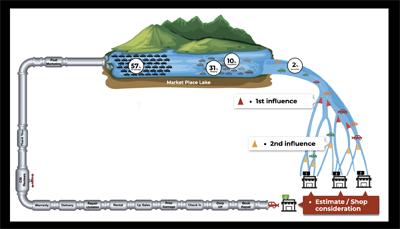CIECA hosted its latest CIECAST webinar March 30, “How to Adapt to the Speed of Change in the Collision Industry… Without Getting Crushed,” presented by Ryan Taylor, founder of the CRM software BodyShop Booster and president of The AMP Bureau.
Taylor shared three concepts he said are helping some of the great leaders around the world adapt to the speed of change---and are also applicable to anyone in the collision repair space.
The full presentation is available on CIECA’s website.
Upstream Positioning
Taylor said it is important to understand there are different classifications of purchases.
The first is an impulse buy. These come with a high degree of purchase motivation because they are something people really want---like a car or new smartphone—so customers tend to do a lot of research before buying them.
The second, which includes collision repair, is a distress purchase. These have no degree of purchase motivation because people don’t really want it, but need it.
“It’s a very different buying frame of mind,” Taylor said. “You can’t make people research what to do after they’ve had an accident. You can’t create interest in the product by offering discounts if they get in an accident. You can’t build demand by causing accidents.”
In any given market, about 57% of vehicle owners do not have damage and therefore do not need collision repair, Taylor said.
For the other 43%, their buying behavior depends on how much damage their vehicle has. If it’s small, many people will put off getting it fixed for a long time, even years. For those with medium damage, they tend to put it off for a few months. But those with large damage will make the decision to purchase collision repair services within a matter of hours.

“Only about 2% of people are looking for collision repair,” Taylor said. “It fluctuates with conditions [like extreme weather events] but that’s the average.”
Those in the collision repair space need to think about how to “move upstream” in a potential customer’s journey.
“Everyone has a ‘lake,’” Taylor said. “If you’re a body shop, the lake is the surrounding community; if you’re a supplier, it’s a larger area.”
As customers in the “lake” decide to purchase collision repair services, they “move downstream towards ‘islands of influence’” that affect their decisions on which shop to use---like insurance companies, OEMs and family and friends, Taylor said.
Beyond that is a second chain of “islands,” like a body shop’s website and social media presence, and the results of a Google search of local shops. These secondary influencers are nowhere near as powerful as the primary ones, Taylor said.
“The average customer looks at three body shops,” Taylor said. “Then they finally make a buying decision.”
Now that customer is in the “repair tube,” in which they book the repair, drop off the vehicle, pick up their rental vehicle, get repair updates, take delivery and get a warranty, at which point they are “pumped back” into the “lake” as part of the 57% of repaired vehicles that don’t need services.
“Think about how you move upstream in that cycle,” Taylor said.
As an example, Taylor said, he went to dealerships after hail storms to offer dent repair services, but a lot of other repairers were doing the same thing, so he had to “move upstream.”
To do that, he identified dealerships in hail-prone areas, and spoke to the principles at those dealerships about setting up a disaster response plan---before any storm hit, so he was the only one in the room. That way, when a storm did hit, the dealership called him directly to get the response started immediately.
Another example is the AMP Bureau, which helps shops provide nationwide warranties across the U.S. and Canada. This means warranties are no longer void when the car is sold, which creates a higher resale value. Shops can show owners how the AMP warranty will increase their car’s Kelley Blue Book value, and owners can show the AMP warranty when selling it.
“What can you do to start upstream thinking?” Taylor said.
Moving Away from Fear and Toward Freedom
Taylor said new technology being applied to vehicles can be scary, but the industry should embrace and try to keep up with it.
As an example, he said the U.S. military dedicates 20% of its annual budget to research and development of new technology.
How to Surf the Technology Wave
In 1995, Taylor said, there were only four marketing channels---the radio, Yellow Pages, TV and newspaper. Today there are 7,400 different marketing channels.
“Don’t chase the latest marketing craze,” Taylor said. “Focus on the customer.”
Today, people are constantly looking at their phones, but in 1940, in a photo he showed, they were all looking at newspapers.
“The delivery method has changed but human behavior hasn’t, so focus on that,” he said.
Taylor drew a parallel to surfing.
“Inexperienced surfers chase the wave,” Taylor said. “Experienced surfers choose their spot and wait. It looks like they’re not doing much but they are positioned to catch the wave when it comes.”











Abby Andrews